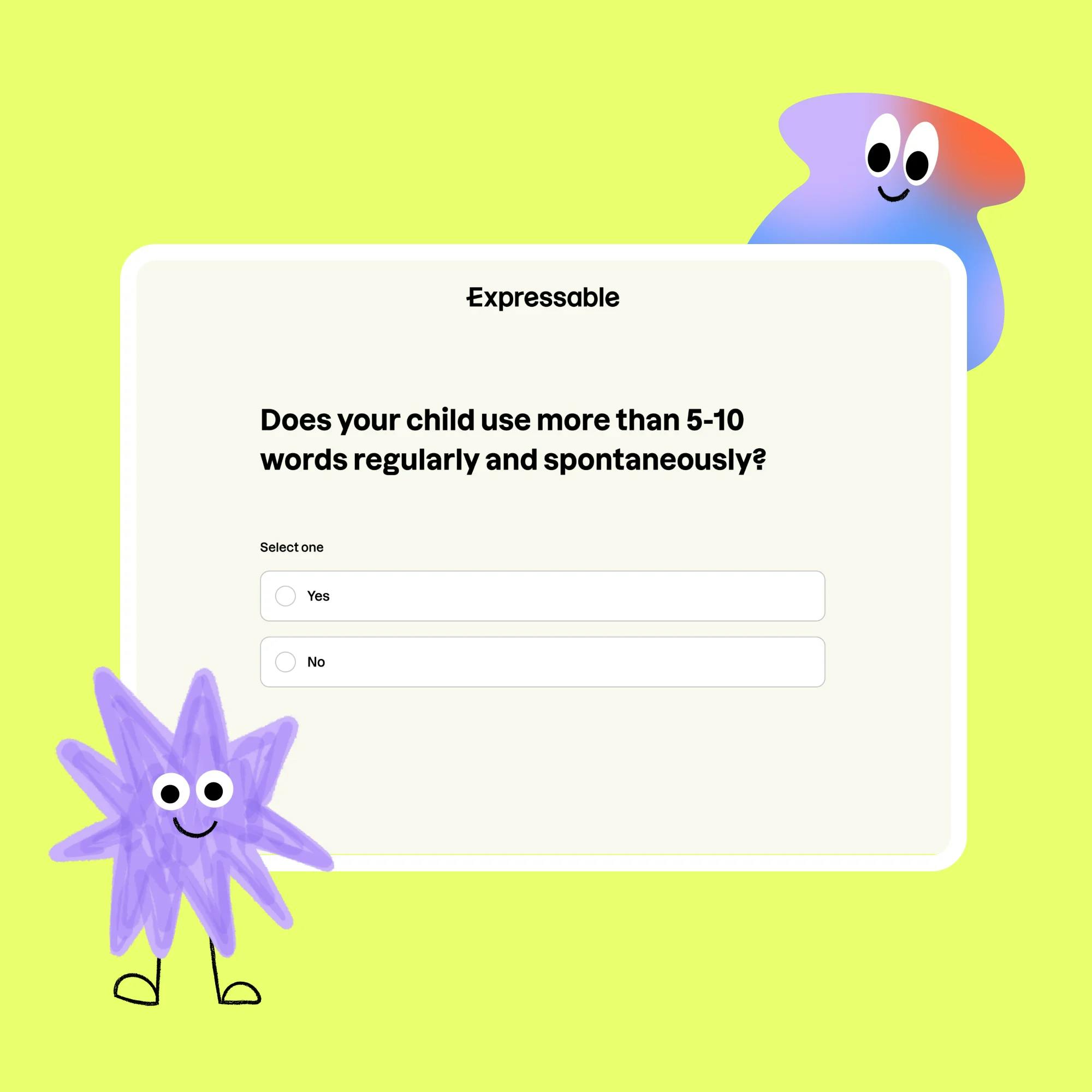Many children have a hard time with articulation. This means they have difficulty producing speech sounds correctly, and some of what they say may be tough to understand. But when a child’s speech is extremely difficult to understand, it’s worth exploring whether apraxia is present.
Here we’ll explain the signs of childhood apraxia of speech, how it’s different from an articulation disorder, and what you need to know about speech therapy for apraxia.


What is apraxia of speech?
Apraxia of speech is a motor-planning disorder. A person with apraxia has the language capacity to talk, but the signals between their brain and mouth muscles aren’t sent correctly. This can create a lot of frustration. A seemingly simple task that most of us do every day–speaking clearly–can be very challenging for people with apraxia.
Apraxia can be something a person is born with, called childhood apraxia of speech, or CAS for short. Apraxia can also happen later in life after an event like a stroke, traumatic brain injury, tumor, or progressive disease. This is called acquired apraxia of speech. In this article we’re focusing on childhood apraxia of speech.


Signs of childhood apraxia of speech
There are several characteristics to watch for to know if your child may have apraxia. These can be:
Inconsistency in pronouncing words. One of the first things you may notice with apraxia is a person’s inconsistency in how they speak. Maybe they can pronounce the word “caterpillar” clearly one time. But the next time they say it, it comes out differently and it’s hard to understand. This inconsistency is one of the hallmark symptoms of apraxia of speech.
Distorted sound production. Saying words in a distorted way is a symptom of apraxia. A child’s speech may not be as crisp and precise as it could be. Or they may be quite challenging to understand, period. Some kids with apraxia can say a complex word clearly, but simple words are more distorted. It’s important to note that there can be varying levels of severity. No two people with apraxia will be exactly the same.
Problems pronouncing vowels. Vowel production is another giveaway. If a child can’t pronounce vowels correctly, this can be a sign of apraxia of speech. They may say “shaw” instead of “shoe,” or “meh” instead of “me.” Even the smallest variation in tongue or jaw movement can affect how vowels sound, which is why kiddos with apraxia often have this challenge.
Groping movements of the mouth. This characteristic isn’t present in everyone with apraxia. And it doesn’t happen all the time. But it’s a symptom to look out for. As a person begins to talk, they’ll try to place their mouth, tongue, teeth, and jaw in the correct position. Although they know what they’re trying to say, they can’t get their mouth muscles to move in the correct way. So they move their muscles in a groping type of way, as if they’re searching for the right position. This is related to the disconnect between the brain’s message of what needs to be said, and the muscles’ difficulty in following that command.
Difficulty with intonation of speech. Kids with apraxia may also struggle with their intonation of speech. This refers to the natural, up-and-down tone and inflection we use when we talk. For example, when you’re asking a question, your inflection rises a little at the end of the sentence to convey that it’s a question.
Automatic speech easier than volitional speech. Kids with apraxia may have an easier time with automatic speech than with volitional speech. Volitional speech is speech that a person initiates, such as asking a question, making a comment, or participating in a conversation.
Examples of automatic speech include stating your name or birthday, counting to 10, saying the days of the week, or singing a song you know by heart. Automatic speech is ingrained in us, and it’s likely to come out more smoothly than answering questions or making comments in conversation.


How is childhood apraxia of speech different from an articulation disorder?
As we mentioned above, many children have a hard time pronouncing certain sounds or producing clear speech.
If a child has an articulation disorder, you’ll notice that there’s a pattern to their speech errors. For example, maybe they always substitute a /b/ for a /v/ sound, so vacuum is always produced as bacuum. With apraxia, the errors and the ways words sound are inconsistent.
Children with an articulation disorder likely only have a tough time pronouncing consonants, such as /s/, /r/, /k/, or /l/. Difficulty pronouncing vowels correctly can be a sign of childhood apraxia of speech.
Is speech therapy needed for childhood apraxia of speech?
A child isn’t likely to outgrow apraxia without speech therapy. A speech therapist is licensed and trained to evaluate speech sound production and determine if a child has apraxia or simply an articulation delay.
During a speech and language evaluation, the speech therapist will assess the types of sound errors they hear, and whether they occur at the single-word level or in connected speech. Once the speech therapist knows which disorder is present, they can create an individualized treatment plan and goals for your child.
A child isn’t likely to outgrow apraxia without speech therapy.
Goals are specific to each person, and they’re designed to be measurable so the therapist can track your child’s progress. Here’s an example of a therapy goal for someone with apraxia of speech:
The client will produce multisyllabic words with 80% accuracy, given moderate multimodal cues, in order to improve speech production to a more intelligible level.
Speech therapy for apraxia is all about learning new motor patterns and improving speech-motor coordination. Children need frequent and consistent therapy in order to learn how to move their mouth muscles purposefully. That’s why the frequency of speech therapy sessions for apraxia is so important. For children, having at least three sessions a week is recommended in order to make appropriate progress. Research supports more frequent, shorter sessions of therapy. Three sessions of 30 minutes or less are effective. Some speech-language pathologists recommend 5 sessions per week at 15 minutes each.
How to find a speech therapist who treats childhood apraxia of speech
There are several ways you can find a speech therapist who treats apraxia in children. The first is to reach out to any friends or acquaintances who have firsthand experience with speech therapy. Word-of-mouth recommendations are always helpful. You can also contact your child’s pediatrician. They likely have a list of speech therapists that they recommend.
For any therapist you’re considering, call their office and ask about their background in treating childhood apraxia of speech. While apraxia is within the scope of practice for all speech therapists, some therapists have more experience than others in this area. Search for online reviews of the speech therapist as well.
Many families find online speech therapy to be a convenient choice, especially for a condition like apraxia, which requires frequent sessions.
Apraxia Kids offers an online registry of speech therapists across the United States and Canada who have experience treating children with apraxia of speech. You can search by location to find a speech therapist near you.
Be sure to consider the logistics of your child’s speech therapy sessions. How far is the commute? Do the available session times work with your schedule? Many families have found online speech therapy to be a more convenient choice, especially for a condition like apraxia, which requires frequent sessions. Many studies have shown that online speech therapy is just as impactful and effective as therapy provided in person.


Once you’ve found a speech therapist, prepare any questions you have. You can call ahead of your child’s evaluation, or bring your questions to the evaluation. Speech therapists know this can be an uncertain and anxious time for families, and they’ll work to answer your questions and assure you of their plan for your child’s treatment.
Don’t wait to begin the process of getting your child into speech therapy if you have concerns about their communication. The more quickly you can start therapy, the faster they can begin making progress! You can learn more about how Expressable evaluates and treats apraxia of speech in our treatment guide. Or, click here to get matched with a speech therapist.
How Expressable Can Help
Concerned your child isn't reaching age-expected milestones? Looking for communication support from a professional? Expressable is a national online speech therapy practice serving children and adults. We treat all major areas of communication and feeding, offer flexible hours including evenings and weekends, and accept most major health insurance plans. We’re proud to have earned more than 3,000 5-star reviews from our clients (4.9/5 average).
Our therapy model is centered on parent and caregiver involvement. Research proves that empowering caregivers to participate in their loved one’s therapy leads to better outcomes. That’s why we combine live, 1-on-1 speech therapy with personalized education and home practice activities for faster progress.
Communication is more than words. It’s how we share how we feel and show who we are. We’re here to help you or your child do just that.
 Abby Barnes, M.S., CCC-SLP
Abby Barnes, M.S., CCC-SLP











